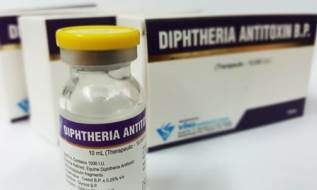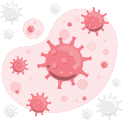Definisi
Difteri merupakan sebuah infeksi bakteri serius yang biasanya menyerang membran mukosa dari hidung dan mulut. Penyakit ini dapat diterapi dengan obat-obatan. Namun, pada stadium yang lanjut, difteria dapat mengakibatkan kesulitan bernafas, gagal jantung, kelumpuhan, dan gagal ginjal. Difteria juga dapat mengancam nyawa meskipun dengan terapi, terutama pada anak-anak.
Sebelum era vaksin, difteri merupakan penyebab utama kematian anak-anak di seluruh dunia. Pada negara yang berhasil menjalankan program imunisasi, saat ini kasus difteria sudah hampir tidak pernah terdengar. Namun meskipun begitu, difteri sampai sekarang masih menyebabkan kesakitan global dan terus menjadi wabah pada negara dengan tingkat vaksinasi yang rendah. Pada tahun 2018, terdapat 16.000 kasus difteria yang dilaporkan ke WHO.
Penyebab
Difteri disebabkan oleh bakteri Corynobacterium diphtheriae yang bermultiplikasi pada permukaan tenggorokan atau kulit. Bakteri ini menyebar dari manusia ke manusia dan penyebarannya terjadi melalui:
- Droplet pernafasan. Ketika seseorang yang terinfeksi batuk atau bersin, ia akan mengeluarkan droplet yang terkontaminasi. Orang didekatnya akan menghirup bakteri yang terkandung didalamnya. Penularan dengan cara ini adalah yang paling sering dan mudah terjadi, terutama pada keramaian
- Memegang barang milik orang yang terinfeksi, yang mungkin terkontaminasi bakteri
- Menyentuh luka terbuka atau sariawan dari penderita
Faktor Risiko
Beberapa faktor yang dapat meningkatkan risiko terkena difteri adalah:
- Anak dan dewasa yang tidak vaksinasi secara teratur
- Orang yang tinggal di tempat padat penduduk dan lingkungan tidak higienis
- Orang yang bepergian ke area dengan kasus difteri yang tinggi
Gejala
Difteri dapat menginfeksi saluran pernafasan dan kulit. Gejalanya bergantung pada bagian tubuh yang terkena dan biasanya baru muncul 2-5 hari setelah seseorang terinfeksi. Gejala dan tandanya meliputi:
1. Difteri pernafasan. Bakteri diphtheriae paling sering menginfeksi saluran pernafasan. Ketika bakteri tersebut masuk dan menempel pada mukosa atau dinding saluran nafas, hal ini akan menyebabkan:
-
- Kelemahan
- Sakit tenggorokan
- Suara serak
- Demam ringan dan menggigil
- Pembesaran kelenjar getah bening di leher
- Kesulitan bernafas atau nafas cepat
- Hidung berair
- Kelelahan
Bakteri C. diphtheriae memproduksi racun yang membunuh jaringan sehat pada saluran pernafasan. Dalam waktu dua sampai tiga hari, jaringan yang mati tersebut membentuk selaput keabuan yang dapat memenuhi tenggorokan atau hidung. Selaput keabuan yang tebal ini disebut dengan “pseudomembran”. Pseudomembran ini dapat terbentuk di hidung, amandel, pita suara, dan tenggorokan sehingga menyebabkan kesulitan bernafas dan menelan.
Jika racun tersebut sampai ke aliran darah, dapat mengakibatkan kerusakan jantung, saraf, dan ginjal.
Pada beberapa orang, infeksi dapat hanya menyebabkan gejala ringan atau bahkan tanpa gejala sama sekali. Namun, orang-orang ini tetap dapat menularkan bakteri
2. Difteri kulit. Bakteri diphtheriae juga dapat menginfeksi kulit dan menyebabkan nyeri, kemerahan, bengkak, dan luka yang bisa tertutup oleh selaput keabuan. Gejala ini mirip dengan infeksi bakteri pada kulit lainnya. Namun, infeksi kulit ini jarang menyebabkan penyakit yang serius.
Diagnosis
Diagnosis bergantung pada tipe difteri. Dokter biasanya mendiganosis difteri dengan melihat tanda dan gejala yang ada. Pemeriksaan tes usap atau swab pada dinding belakang tenggorokan atau hidung untuk mendeteksi adanya bakteri dapat dilakukan. Dokter juga dapat mengambil sampel dari luka terbuka dan menumbuhkan bakterinya di laboratorium. Jika bakteri tersebut tumbuh dan memproduksi racun, maka diagnosis difteri menjadi pasti. Namun, menumbuhkan bakteri membutuhkan waktu yang lama, sehingga terapi perlu untuk segera dimulai jika seseorang dicurigai menderita difteri pernafasan.
Tata Laksana
Pengobatan dan perawatan untuk difteri meliputi:
- Antitoksin difteri untuk menghentikan produksi racun oleh bakteri sehingga tidak menimbulkan kerusakan jaringan. Terapi ini sangat penting untuk difteri pernafasan, namun jarang digunakan untuk difteri kulit.
- Antibiotik untuk membunuh bakteri. Terapi ini penting untuk difteri pernafasan dan difteri kulit. Selain itu, antibiotik juga bermanfaat untuk menurunkan penularan. Seseorang biasanya tidak lagi dapat menginfeksi orang lain dalam waktu 48 jam setelah meminum antibiotik. Namun, penting untuk menghabiskan antibiotik yang telah diresepkan oleh dokter untuk memastikan seluruh bakteri sudah mati. Setelah antibiotik habis diminum, dokter akan melakukan pemeriksaan untuk memastikan bakteri benar-benar sudah tidak ada di dalam tubuh.
Komplikasi
Jika tidak diterapi dengan baik, difteri dapat mengakibatkan komplikasi seperti:
- Sumbatan jalan nafas oleh psudomembran
- Kerusakan otot jantung (miokarditis). Racun difteri dapat menyebar melalui aliran darah dan merusak jaringan lain di dalam tubuh. Sebagai contoh, racun dapat merusak otot jantung sehingga menyebabkan komplikasi seperti peradangan pada otot jantung (miokarditis). Kerusakan jantung akibat miokarditis dapat bersifat ringan ataupun berat. Pada kasus berat, miokarditis dapat berujung pada gagal jantung dan mati mendadak
- Kerusakan saraf. Racun juga dapat merusak saraf. Target saraf yang umumnya terkena adalah tenggorokan, dimana akan terjadi kesulitan menelan. Selain itu, saraf pada lengan dan tungkai juga dapat meradang sehingga menyebabkan kelemahan otot. Jika toksin merusak saraf yang berfungsi untuk mengatur otot pernafasan, maka akan terjadi kelumpuhan otot nafas. Pada kondisi ini, seseorang akan membutuhkan alat bantu nafas mekanik
- Gagal ginjal akibat racun
- Pada beberapa orang, difteri pernafasan dapat menyebabkan kematian. Bahkan meskipun sudah diterapi, sekitar 1 dari 10 orang dengan difteri pernafasan meninggal dunia. Tanpa terapi, lebih dari setengah penderita difteri akan meninggal. Angka kematian lebih tinggi pada anak dibawah 5 tahun dan dewasa di atas 40 tahun
Pencegahan
Cara terbaik untuk mencegah difteri adalah dengan mengikuti imunisasi sesuai jadwal yang telah ditetapkan oleh Kementerian Kesehatan. Vaksin difteri diberikan untuk bayi, anak, remaja, dan dewasa. Terdapat empat jenis vaksin yang dapat digunakan yaitu: DTaP, Tdap, DT, dan Td. Setiap vaksin ini mencegah difteria dan tetanus, sedangkan DTap dan Tdap yang mengandung komponen ‘p’ juga berguna untuk mencegah pertusis atau batuk rejan.
- Vaksin DTaP atau DTwP diberikan pada anak kecil yaitu pada usia 2,4, dan 6 bulan atau 2,3,4 bulan. Booster pertama diberikan pada usia 18 bulan. Booster kedua diberikan pada umur 5-7 tahun atau pada program bulan imunisasi anak nasional (BIAS) kelas 1.
- Vaksin Td atau Tdap diberikan pada pra-remaja yaitu usia 7 tahun atau lebih. Booster selanjutnya pada umur 10-18 tahun atau pada program BIAS kelas 5
- Booster Td diberikan untuk orang dewasa setiap 10 tahun. Hal ini berkaitan dengan penelitian yang menunjukkan bahwa vaksin yang mengandung toxoid difteria memberikan perlindungan pada 95 dari 100 orang yang menerimanya. Perlindungan ini bertahan selama sekitar 10 tahun.
Kebanyakan orang yang mendapatkan vaksin difteri tidak mengalami efek samping yang serius. Namun, efek samping tentu dapat terjadi meskipun kebanyakan hanya bersifat ringan atau tidak memengaruhi aktivitas sehari-hari.
Beberapa orang dengan kondisi medis tertentu tidak disarankan untuk mendapatkan vaksin atau harus menunggu untuk pemulihan kesehatan sebelum mendapatkan vaksin. Anda sebaiknya bertanya ke dokter apakah Anda boleh mendapatkan vaksin.
CDC merekomendasikan bahwa seseorang yang mengalami kontak erat dengan penderita difteri agar menerima antibiotik untuk mencegah kesakitan. Langkah ini disebut profilaksis (pencegahan).
Kapan Harus ke Dokter?
Segera hubungi dokter bila Anda atau orang terdekat Anda terpapar dengan penderita difteri. Jika Anda tidak yakin apakah anak Anda atau Anda sudah divaksin difteri, segera lakukan vaksinasi atau konsultasikan dahulu dengan dokter Anda.
Mau tahu informasi seputar penyakit lainnya? Cek di sini, ya!
- dr Nadia Opmalina
Diphtheria | CDC. Cdc.gov. (2022). Retrieved 18 February 2022, from https://www.cdc.gov/diphtheria/index.html.
Diphtheria - Symptoms and causes. Mayo Clinic. (2022). Retrieved 18 February 2022, from https://www.mayoclinic.org/diseases-conditions/diphtheria/symptoms-causes/syc-20351897.
Lamichhane, A., & Radhakrishnan, S. (2022). Diphtheria. Ncbi.nlm.nih.gov. Retrieved 18 February 2022, from https://www.ncbi.nlm.nih.gov/books/NBK560911/.
Diphtheria: Background, Pathophysiology, Epidemiology. Emedicine.medscape.com. (2022). Retrieved 18 February 2022, from https://emedicine.medscape.com/article/782051-overview.






/62d2542a6fbfe.jpg)





